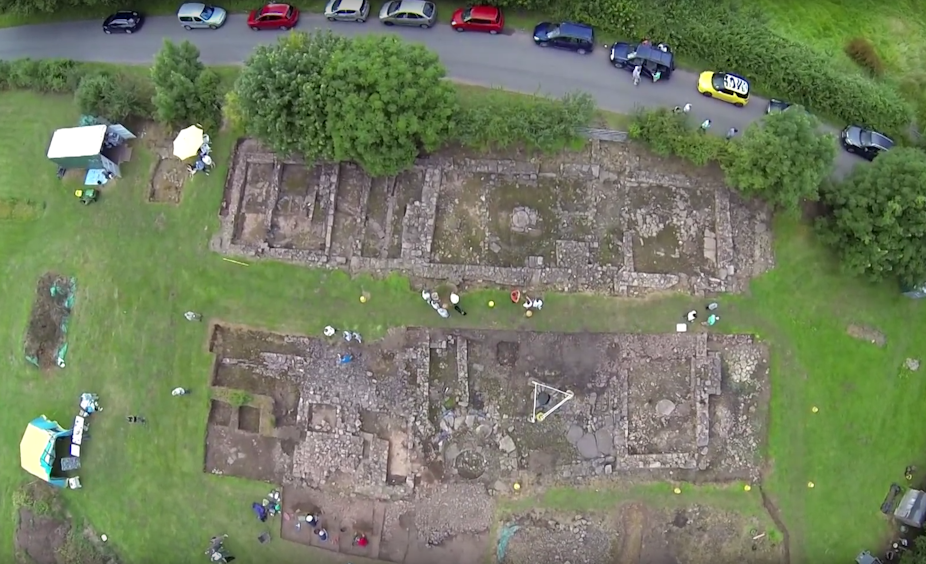The tale of how an amateur archaeologist’s hunch led him to uncover a lost medieval town and spend £32,000 of his own money to buy the land, would stand to be the archaeological discovery of any year. On the border between England and Wales, the site of the medieval town of Trellech reveals much about a tumultuous period of history – and how the town came to be lost.
The story begins in 2004, when archaeology graduate Stuart Wilson began his search for this lost medieval town in Monmouthshire, south-east Wales, near where now only a small village bears the name. In the face of scepticism from academic archaeologists, Wilson’s years of work have been vindicated with the discovery of a moated manor house, a round stone tower, ancillary buildings, and a wealth of smaller finds including pottery from the 1200s.

The town could turn out to be one of the largest in medieval Wales, and while there is more work to be done, the evidence is building. The large number of finds – including metalwork, cooking vessels and decorated pottery – point to a large settlement, and are essential in helping archaeologists date the site. What they suggest is a short-lived but intensive period of occupation between the 12th and early 15th centuries, during which the town was founded by the De Clare family as an industrial centre and later destroyed during the Owain Glyndwr rebellion in 1400. This was a period of instability on the Welsh border, with conflict between rival Welsh princes and the English throne. Settlements like Trellech would become the focus of such clashes, culminating in Glyndwr’s rebellion.
Ever-disappearing archaeology
What makes the lost city of Trellech so important is its rarity and the quality of its preservation. Most large medieval settlements in England and Wales are still towns and cities to this day. This means archaeological investigations of medieval London or York for example are difficult and expensive, and can only occur piecemeal as urban redevelopment allows excavation of small areas. If Trellech turns out to be an extensive town, it will be a unique and important site. As archaeology is key to understanding the lives of everyday people who are ignored by the histories of the great and the good, sites like Trellech are the only way we gain these insights.
It may seem surprising that an entire medieval town could become lost from the historical record for more than 500 years, but in fact this is more common than you might think. Medieval Britain was characterised by poor documentary records, particularly outside major centres of political or religious power like London, Edinburgh, York or Canterbury. A settlement could be destroyed, fall into decline, or be abandoned – and if no written records existed or those that did were subsequently lost, it’s quite possible for there to be no account of its existence.
At the very least, the precise location of a settlement can be hard to trace as over time land is reclaimed as farmland, or stonework that might otherwise last is removed for buildings elsewhere. Wooden structures decay within decades. Sites on flood plains can be covered by metres of alluvial (fertile clay, silt and sand) deposits, while upland settlements may be reforested. And in modern times, mechanical ploughing has been extremely destructive to the archaeological record. Due to any or all of these natural processes, finding a lost site requires dedication and concerted archaeological research, or a chance find.
Given the many things that could have damaged medieval Trellech’s remains beyond recognition, it is incredibly significant that it survives in such good condition. The longer back into the past we look, the more common it is to lose settlements, buildings or monuments – particularly into prehistory, before documentary evidence. Trellech is proof that any field in the UK could conceal an important site, and this is precisely why professional archaeological investigation before building work is essential.
One man’s dedication
Trellech’s discovery is also important due to how it was found. Most important discoveries in Britain are uncovered by professional archaeologists undertaking paid work, and the number of these discoveries easily dwarf the work done by university researchers. But in this case, Trellech was revealed through the commitment and perhaps bloody-mindedness of one man and a dedicated team of volunteer archaeologists.
British archaeology as a discipline and profession grew out of exactly this kind of work: in the 19th and early 20th centuries fresh archaeological ground was broken by the likes of Nancy Newbigin, John Mortimer and Canon William Greenwell, all working as unpaid, self-taught experts in what was then a new field of learning.
So in this sense, Wilson and his team belong at the heart of one of the great traditions of archaeological research: all over the country local societies and archaeological associations work tirelessly in the same way to uncover neglected corners of Britain’s past. Long may they continue.

